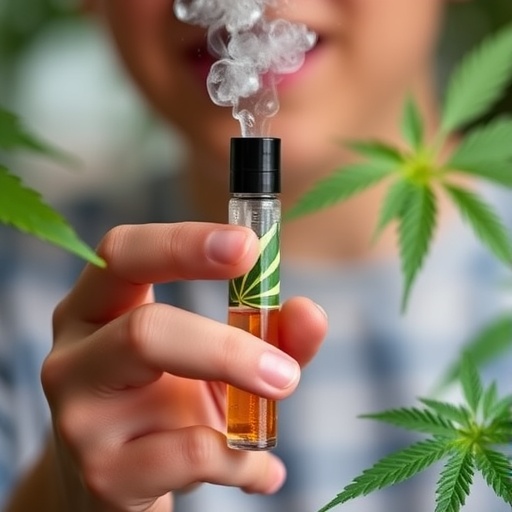Flavored Marijuana Vaping Surges Among American Adolescents: A Growing Public Health Concern
Recent findings from the University of Michigan’s nationally representative Monitoring the Future surveys reveal a striking rise in the prevalence of flavored marijuana vaping among American teenagers. This burgeoning trend, documented between 2021 and 2024, signals a notable shift in substance use behaviors within this vulnerable population. The study, financially supported by the National Institute on Drug Abuse, identifies flavored vaping solutions as becoming the predominant mode of cannabis consumption among youth who vape marijuana, suggesting significant implications for public health, regulatory policies, and future research.
The data highlights particularly sharp increases in flavored marijuana vape use among younger adolescents, notably eighth graders. From 2021 to 2024, the proportion of eighth graders who reported vaping flavored marijuana solutions surged from 47% to 63%. Similarly, older adolescents displayed parallel trends; flavored vaping increased from 41% to 53% among 10th graders and from 36% to 50% among 12th graders. These marked increases underscore a growing preference for flavored cannabis products that may enhance the appeal and accessibility of cannabis for youth.
Concurrently, the overall percentage of marijuana users who opted to vape rather than consume cannabis through traditional smoking methods also rose throughout the study period. Among eighth graders who had used marijuana in the past year, the share engaging in vaping increased from 48% to 57%. In 10th grade, this number grew from 60% to 66%, while among 12th graders, it climbed from 58% to 67%. This upward trajectory points to not only a shift in the method of consumption but also potential changes in social and behavioral dynamics surrounding adolescent cannabis use.
The appeal of flavored vaping products may be driven by several technical and sensory factors, as explained by Richard Miech, principal investigator of the Monitoring the Future study. Vaping solutions offer a reduced sensory footprint compared to traditional cannabis smoking; the absence of the characteristic strong cannabis odor facilitates discreet use. Flavor additives, particularly fruit flavors, mask the natural taste of cannabis, making the act of consumption more palatable and attractive to adolescents. This sensory masking, coupled with the compact and concealable nature of vaping devices, potentially lowers social and environmental barriers to usage.
Beyond the rising prevalence, these trends raise substantial public health concerns, especially regarding the risk of cannabis addiction among youth. Cannabis use disorder, characterized by problematic use leading to significant impairment, appears more prevalent among adolescents than previously recognized. Statistics indicate that approximately 5% of adolescents meet the criteria for cannabis use disorder, surpassing the 3% affected by alcohol use disorder. Given that addiction can seriously disrupt academic performance, social relationships, and psychological well-being, the surge in flavored marijuana vaping poses a critical challenge for healthcare professionals and policymakers.
The research illustrates additional nuances in adolescent attitudes towards cannabis. Interestingly, despite the increase in flavored marijuana vaping, perceived risk associated with cannabis use has risen among youth, while social acceptability has decreased between 2021 and 2024. This paradox suggests that factors driving flavored cannabis vaping may be distinct from general cannabis perception metrics. Flavored vaping solutions, with their novel sensory profiles and discrete consumption methods, may circumvent traditional deterrents associated with cannabis use, warranting specialized focus in future attitude and behavioral studies.
Faced with these trends, policymakers and public health officials ponder the efficacy of regulatory interventions, particularly the potential impact of restricting flavors in cannabis vaping products. While flavor bans might intuitively reduce appeal, evidence from other substance use domains, such as cigarette smoking, indicates complexity in outcomes. Adolescents determined to consume flavored cannabis may switch to unflavored vaping or revert to smoking cannabis, potentially nullifying intended public health gains. Moreover, resistance from adult users in legalized cannabis states and industry lobbying complicate the enactment and enforcement of flavor restrictions.
An alternative strategy gaining traction focuses on demand reduction rather than supply limitation. By employing targeted educational campaigns, media strategies, and social interventions to reduce adolescents’ interest in cannabis overall, including flavored vaping products, public health authorities aim to emulate the successes achieved in reducing youth tobacco use. Since 1998, the prevalence of cigarette smoking among 12th graders plummeted from 35% to a mere 3% in 2024, despite the continued legality and availability of cigarettes. Multipronged efforts encompassing public education and stringent marketing regulations effectively shifted youth attitudes and behaviors away from tobacco.
Such demand-side approaches highlight the importance of addressing the underlying drivers of substance use initiation and persistence among adolescents. Messaging that counters normalization, clarifies health risks, and promotes resilience may attenuate the allure of flavored cannabis products. This approach necessitates nuanced understanding of youth culture, perception shifts, and rapidly evolving cannabis product innovations to remain relevant and effective. Researchers caution, however, that demand reduction should be integrated with broader regulatory frameworks for maximized impact.
Industry stakeholders also play a pivotal role in these evolving dynamics. The cannabis industry must recognize that escalating youth cannabis use jeopardizes public trust and may provoke stringent regulatory backlash. As Richard Miech notes, portraying the cannabis sector as a threat to children could galvanize bipartisan political will toward stricter controls and oversight. Responsible industry practices that limit youth-oriented marketing, product accessibility, and ensure transparency could partially mitigate these risks while supporting sustainable market growth.
In summary, the recent rise in flavored marijuana vaping among American adolescents is a multifaceted issue with significant implications for public health, regulatory landscapes, and future scientific inquiry. The increased adoption of flavored cannabis vaping reflects complex sensory, behavioral, and social factors that enhance product appeal and accessibility among youth. Simultaneously, this trend heightens concerns about addiction risk and underscores the necessity of informed, strategic interventions that balance supply restrictions with demand reduction initiatives. Ongoing surveillance and research remain critical to unraveling the nuanced pathways of adolescent cannabis use and shaping effective policies.
The University of Michigan study serves as a timely alert, emphasizing the pressing need for coordinated efforts among researchers, public health professionals, educators, regulators, and industry representatives to safeguard adolescent health. By advancing understanding of vaping behaviors, sensory influences, and social determinants, stakeholders can design targeted, evidence-based strategies to curb youth cannabis use amidst evolving market trends. As flavored marijuana vaping continues to gain traction, proactive and collaborative responses will be paramount in addressing this emerging public health challenge.
Subject of Research: Trends in adolescent use of vaping and flavored cannabis solutions in the United States between 2021 and 2024.
Article Title: Trends in US Adolescent Use of Vaping and Flavored Solutions for Marijuana Consumption, 2021-2024
News Publication Date: 2024
Web References:
University of Michigan Monitoring the Future Study
DOI link to study
References:
Miech, R.A., et al. (2025). Trends in US Adolescent Use of Vaping and Flavored Solutions for Marijuana Consumption, 2021-2024. Journal of Adolescent Health. https://doi.org/10.1016/j.jadohealth.2025.07.004
Image Credits: Not provided.
Keywords: Health and medicine; Health care; Human health; Adolescent health; Cannabis; Vaping; Flavored marijuana; Substance use trends; Addiction; Public health policy
Tags: adolescent substance usecannabis consumption among teensflavored marijuana vaping trendsflavored vape products riseimpact of flavored cannabismarijuana use among eighth gradersmonitoring youth substance useNational Institute on Drug Abuse findingspublic health concerns marijuanaregulatory policies on vapingvaping statistics 2021-2024youth addiction risks





